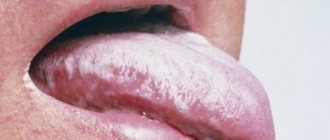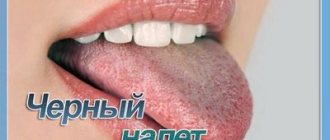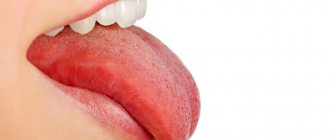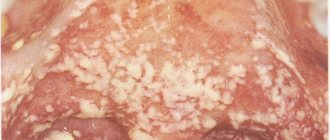White coating on the tongue is a layer of organic substances, bacteria and dead cells, accompanied by swelling of the papillae of the tongue, which can indicate various diseases of the lungs, kidneys or gastrointestinal tract: gastritis, stomach ulcers, enterocolitis.
Plaque on the tongue is a common phenomenon, which many consider simply a feature of their body. And they often forget that you need to brush not only your teeth, but also your tongue. However, many do not know that the appearance of plaque is a symptom usually associated with digestive problems. And it is necessary not only to regularly clean off plaque, but to find the root of the problem and select the appropriate treatment.
If you do not undergo treatment and do not carry out oral care procedures daily, the tongue looks as if it is burned, and bad breath appears. The correct treatment is prescribed by the doctor after testing, and we will try to figure out how to remove plaque from the tongue.
Why do you need to clean your tongue?
When considering the question of how to get rid of white coating on the tongue, you need to start with the basics. The tongue of a healthy person should have a pink color, the surface should be elastic and slightly moisturized. At the same time, a light white coating is not considered a pathology, and this nuisance can be easily eliminated by ordinary cleaning. It's another matter when a strong coating appears. This may indicate the presence of a serious disease in the body.
Cleaning your tongue from plaque at home helps solve the following problems:
- Reduces the concentration of pathogenic bacteria in the oral cavity;
- Prevents the appearance of tartar and caries;
- Freshens breath;
- Improves the functioning of taste buds.
Cleaning your tongue with a tongue scraper
Nowadays, tongue scrapers take pride of place in the list of oral hygiene devices. Almost all of them are made of plastic and are a nozzle with a spoon-shaped tip. This excellent tongue and cheek remover needs to be replaced as often as toothbrushes. If you use it together with a rinse aid, the quality of the procedure will be one level higher. You can buy a tongue scraper at a pharmacy or order it from an online store.
Reasons for appearance
Why does white plaque appear? The main reason lies in food debris that gets stuck between the lingual papillae. As a result, a favorable environment is created for the proliferation of bacteria. Most of these microorganisms die, but do not disappear without a trace. When in contact with saliva and epithelial particles, they stick to the tongue, forming a plaque. In this case, this plaque is partially removed by salivation. The film usually remains in hard-to-reach places, for example, at the root of the tongue. If it is not cleaned in time, it begins to spread to other areas, gradually covering the entire tongue. Considering that these are the remains of bacteria, the likelihood of developing dental diseases increases sharply.
Tongue piercing care
FAQ
It hurts?
This is one of the least painful punctures. Biting your tongue tends to hurt more.
How long will it hurt after the puncture?
Usually the tongue does not hurt after a puncture. But after the puncture, swelling occurs, and this can be quite painful for the next 4-7 days.
Will I be able to speak after the puncture?
Yes. The worst thing will be on the second day, when the tongue swells the most. Further, as the swelling subsides, speech will be restored.
Will there be a lot of blood?
Usually, blood may flow for 10-15 minutes after the puncture, this is normal. There should not be severe bleeding, because... with proper puncture, large vessels are not damaged.
Will I lose my ability to taste?
No. Taste buds are not damaged.
When will my speech be fully restored?
After a week or two, speech will be restored, but minor changes in diction may remain. Keep this in mind if you are a singer or announcer.
Do tongue piercings damage teeth?
If you don’t change the jewelry to a short one and knock it on your teeth a lot, sooner or later the enamel will start to come off. Just don't play with decorations.
How to go to the dentist?
If the procedure requires removing the jewelry, but the piercing is less than 4-5 months old, it can be removed, but you will have to return to the piercer to insert it.
I want a ring on the tip of my tongue!
It is a bad idea. The closer to the tip, the worse the puncture heals, and the ring will very quickly knock off the enamel from the teeth, and their repair will be expensive.
What tongue piercing options are there?
In addition to the usual puncture in the middle, there are also symmetrical punctures on the sides. They heal much more painfully, longer and worse, and there is a risk of touching a vessel. Such punctures cannot be trusted to be performed by a less experienced master.
What to do?
Any piercing is a wound, and to heal it you only need 2 things:
1. Do not interfere with the body’s ability to heal itself.
2. Keep the wound clean so that infection does not get there and cause complications. Tongue and frenulum piercings are especially susceptible to infection, since we have a lot of microbes in our mouths that can easily get there from the outside. Therefore, it is better not to neglect the recommendations.
For complete care you will need only one thing - a mouth rinse, which should contain an antiseptic and should not contain alcohol, mint extract and other aggressive substances. Usually our choice is LACALUT “Aktiv”, PRESIDENT “Profi”, ASEPTA, COLGATE Plax “Comprehensive Protection” or LACALUT “Sensitive”.
So what to do?
Day 0-7: A fresh piercing should be washed every time something gets into your mouth - candy, cigarette, food, finger. But at the same time, it is advisable not to rinse more than 3-4 times a day - otherwise you can spoil the microflora in your mouth, and this is fraught with stomatitis. So we literally try not to open our mouth again.
How to rinse? Place the mouthwash in your mouth and rinse for 30 seconds. In the first days, a white or yellow coating and swelling may appear at the puncture site. There is no need to be scared - this is normal. However, if the swelling has not subsided within a week, you should definitely write or call your specialist and listen to his advice.
Day 8-20:
As soon as the swelling subsides, the tongue almost no longer hurts. But this does not mean that it has healed. Continue to rinse your mouth 2-3 times a day. Closer to the 3rd week, it is worth making an appointment with a specialist to replace the barbell with a shorter one, so that the barbell does not interfere with eating, talking, does not knock off the enamel from the teeth and does not spoil the gums.
How to live with this?
Remember that a puncture is healed not by miracle ointments, but by your body. So take care of your hygiene, eat and sleep well, strengthen your immune system, take vitamins, drink plenty of water and exercise so that any puncture heals faster.
Day 21 and beyond:
Your tongue should no longer hurt. We can say that primary healing has been completed. Usually a barbell of 18-22 mm is placed in a fresh puncture; after 3-4 weeks it needs to be replaced with a shorter one - usually 4 mm shorter. It is better to do this with your master (the replacement itself will be free, in difference from the new rod). It is unlikely that you will be able to replace it yourself; it can be painful and traumatic. And then a long period of tissue adaptation to the foreign body will begin. This usually takes six months to a year, after which you can easily change the jewelry yourself, remove the jewelry for a long time (for several days), and also install an even shorter barbell if it seems that this will be even more convenient.
What not to do?
1. Do not pull the decoration or play with it. The less you disturb the wound, the faster it will heal.
2. Do not remove the jewelry. If you take it out in the first 2 months, you won’t be able to put it back on your own; you’ll have to run to a piercer.
3. Do not use peroxide, alcohol, calendula, Chlorhexidine. Chlorhexidine causes teeth to turn yellow and the microflora to deteriorate; this can lead to stomatitis. Alcohol and peroxide also burn new skin, making the wound take longer to heal, plus it can be painful.
4. Do not eat too hot, salty or spicy food for 1-2 weeks. Do not put anything into your mouth with dirty hands. Remember that the oral cavity is one of the most unhygienic areas of the human body.
5. During the first week, it is not advisable to smoke, drink coffee, alcohol, or take blood thinning medications, including aspirin. All this dilates the blood vessels and blood flows stronger, and the wound takes longer to heal. Nicotine generally inhibits general immunity, thereby increasing the healing time by up to 2 times.
Is it normal:
Q. There is a white coating on the ball or around the puncture!
A. This happens if you rinse your mouth too often, or the rinse is not suitable for your oral microflora. It makes sense to replace it.
Q. I’m drooling like a river, I can’t cope with it!
A. This is how the body sometimes reacts to a foreign body in the mouth - it thinks that it is food. Usually within a week the body gets used to it and it goes away.
Q. The temperature is under 38, and the lymph nodes are swollen!
A. This is also the body’s reaction to a weakened immune system, because All efforts are devoted to treating the puncture. You should only worry when the temperature is above 38.5 - then it’s time to see a doctor.
Q. A month has already passed and it still hurts!
A. And it will be. Because a delicate part of the body has been pierced, which is also constantly in motion. We cannot limit this, so we will just have to be patient a little, it will go away with time.
Tips and tricks
1. Eat before the procedure. Not very dense, but with a noticeable sugar content, especially if you have a tendency to faint. Keep in mind that it will be quite difficult to eat for the next few days.
2. Alcohol makes the swelling even worse. More swelling means more pain, it’s better just not to drink. Nicotine worsens the immune system, the puncture will take longer to heal. It's better to smoke less.
3. If the swelling is very severe and painful, try drinking ice water. Cold reduces swelling and pain.
4. The less you talk, the less swelling there will be, and the faster your piercing will heal. The same applies to “playing” with jewelry.
5. Use hand sanitizer before eating. This will reduce the chance of getting an infection.
Microdermal care
Signs of plaque on the tongue
Tongue plaque can be a physiological phenomenon or a side symptom of a serious disease. In the first case, you can remove the white coating on the tongue yourself, without going to the dentist. In the second, you will need the help of a qualified specialist. A white tongue can directly indicate a fungal infection or dehydration of the body
Physiological signs:
- Uniform white or yellowish color;
- A thin layer through which the lingual papillae are clearly visible;
- No unpleasant odor, pain, or other symptoms;
- Appears for certain reasons, for example, due to thirst;
- Easy to clean with a toothbrush.
Pathological signs:
- Dense consistency, difficult to remove;
- Unhealthy color: yellow, brown, gray;
- Covers the entire surface of the tongue;
- Accompanied by an unpleasant odor;
- A sour or bitter taste appears in the mouth.
Yellow plaque
A yellow coating on the tongue usually indicates digestive disorders. The following tips will help you:
- Carefully observe which foods cause a yellow coating on the tongue and eliminate them from your diet.
- Take Allohol tablets before meals to improve digestion.
- To normalize the functioning of the digestive system, take a decoction of flax seeds.
If the above measures do not help you, consult a gastroenterologist, he will tell you not only how to deal with plaque on the tongue, but also how to get rid of its root cause.
How to remove plaque from the tongue at home
How and with what to clean the tongue of an adult? There are several ways to quickly deal with this problem. Let's look at each of them in more detail.
Scrapers
These are special loop-shaped devices made of hygienic plastic. Scrapers effectively remove plaque without causing discomfort or gag reflexes. The tool must be moved from the base of the tongue to the tip until the film disappears. After this, the mouth can be rinsed with an antibacterial solution.
Toothbrushes
Most models have special pads on the back surface or removable attachments for removing plaque. Hygienic procedures are carried out according to the scheme discussed above. To enhance the effect, you can apply a small amount of toothpaste to the surface of the nozzle.
Irrigators
These are modern devices for comprehensive oral care. The essence of the irrigator’s work is the directed supply of a stream of water, which gently but effectively removes food debris and plaque on tooth enamel and tongue. Irrigators work very delicately, the possibility of damage to the mucous membrane is completely eliminated. In this case, to enhance the effect, water can be replaced with a medicinal liquid with an antibacterial or anti-inflammatory effect.
Spoons
Sold in pharmacies, in appearance they resemble a small spatula with rounded edges. Thanks to this form, the possibility of injuring the tongue is eliminated.
Special spoon attachments are available for irrigators. For example, a replaceable nozzle TS-100E. This instrument is recommended by dentists for daily hygiene procedures; it effectively removes plaque and helps freshen breath.
Rinse
To clean the tongue, decoctions based on medicinal herbs and plants are used:
- Oak bark;
- Propolis;
- Calendula;
- Sage.
However, it is important to understand that it will not be possible to remove plaque with the help of decoctions alone. This method cannot replace mechanical cleaning and is used rather for preventive purposes.
Tongue cleaning spoon
A tongue cleaner is just as great for removing plaque and bad breath as other tongue cleaners. It is a nozzle with a spoon-shaped tip. Using this water-supplying nozzle, you can clean your tongue quite gently and effectively. It is known, for example, that yogis use a wooden spoon or clean their tongue with three fingers wrapped in a clean bandage. You can also use an ordinary teaspoon, but then only for cleaning and, of course, individually.
How to properly clean your tongue with a toothbrush
How to properly clean plaque from your tongue using a toothbrush? To do this, it is enough to follow the following rules:
- Cleaning is performed after basic hygiene procedures: brushing the teeth and rinsing the mouth;
- Plaque is removed with progressive movements: the brush goes in one direction, first from the root to the tip of the tongue;
- Then the brush moves in the transverse direction, and then in the return direction: from tip to root;
- 4-6 movements are made in each direction;
- After this, the inner surface of the cheeks is carefully processed,
- At the final stage, rinse with an antibacterial solution.
White plaque and plugs on the tonsils
04.09.2021
The tonsils are the tonsils on the roof of your mouth that are located close to the larynx. They consist of lymphoid tissue. They belong to paired human organs. The tonsils perform functions such as protective and hematopoietic. In addition, they take part in the development of the immune system . The surface of the tonsils has a cavernous character. These depressions are called crypts or lacunae. Inflammation of the organ causes it to become covered with pus, which clogs the crypts. Because of this, traffic jams form. Next, we will consider information about what diseases are symptoms of inflammation of the tonsils , and what needs to be done.
Causes of white plaque and plugs on the tonsils
In most cases, inflammation of the tonsils indicates a disease called tonsillitis . It can be either acute or chronic.
In addition, the appearance of purulent plaque may be caused by the following reasons:
- frequent ARVI
- runny nose that lasts a long time
- dental disease ( caries )
- diphtheria
- scarlet fever
- infectious mononucleosis, etc.
Food can also cause clogging of lacunae. Products such as cheese, cottage cheese, nuts, seeds can cause specified consequences.
Treatment of inflammation of the tonsils
Inflammation the tonsils is accompanied by bad breath , a feeling of constant sore throat , pain during swallowing and changes in the voice. But these are not all the consequences. Much more serious is the appearance of problems with important vital organs, namely the heart , kidneys and liver .
Such appearances occur due to the fact that toxins enter the circulatory system, which are a consequence of the emergence of pathogenic bacteria in the clogged cavernous bodies of the tonsils . Therefore, treatment of the tonsils should not be delayed. To do this, first of all, you need to consult a doctor for a correct diagnosis and explanation of the treatment method. Very often, the only correct treatment for frequent inflammation of the tonsils is considered to be their surgical removal . However, more and more often there is an assertion that this is not the only way out of the situation; the conservative method also allows one to achieve positive results.
Contrary to the opinion of doctors who insist on removal , other doctors and researchers consider the tonsils to be a very important organ. It not only performs the function of protecting the immune system , but even resists the appearance of malignant tumor cells. Chronic inflammation of the tonsils is treatable, but it takes a long time. To achieve this, there is a set of measures that need to be repeated periodically. These are measures such as:
- physiotherapeutic procedures, for example, UHF, ultrasound and others
- mouth rinses
- lubricating the tonsils with antibacterial agents and injecting with anti-inflammatory drugs
- using medications to strengthen the immune system
Removing purulent plugs from the tonsils
Sometimes it happens that cleansing occurs naturally. At the same time, dense lumps enter the oral , improving the patient’s condition. But if the inflammation is caused by tonsillitis , then pus is constantly released, without giving time for cleansing. The hospital may remove the pus plugs. To do this, they are washed with a special solution. In this case, vacuum suction can also be used under local anesthesia.
Under no circumstances should you attempt to remove traffic jams yourself. Pressing with fingers or other objects can only aggravate the condition; pus can penetrate even deeper into the crypts.
Prevention of congestion in the tonsils
To prevent the occurrence of purulent plugs on the tonsils , after meals you need to gargle with a solution of soda (a teaspoon in a glass of warm water). to treat sore throat :
- furatsilin or streptocid (in the ratio of 20 g of the drug per 100 ml of hot water)
- chlorophyllipt solution in alcohol
- chamomile infusion (1 tsp flowers per glass of boiling water, wait 20 minutes for it to settle)
Published in Otorhinolaryngology Premium Clinic
How to properly clean your tongue with an irrigator
Cleaning the tongue from plaque with an irrigator is carried out in compliance with the following rules:
- The procedure begins with a slight pressure, which gradually intensifies;
- The angle of impact of the jet should vary between 60-90 degrees;
- Duration of cleaning – 2-3 minutes;
- First, the general surface of the tongue is processed, then hard-to-reach areas;
- The procedure must be performed daily, at least once.
It is important to understand that the use of irrigators does not mean giving up mechanical brushing of teeth. Therapeutic liquids for the device are used strictly as prescribed by the doctor.
Prevention of plaque formation on the tongue
- Brush your teeth and tongue at least twice a day;
- Include fermented milk products in your daily diet, eat more vegetables and fruits;
- Reduce the amount of spices, spicy and smoked foods you consume;
- Quit smoking and alcoholic beverages;
- Regularly undergo preventive examinations at the dentist;
- Do not cause diseases of the gastrointestinal tract.
Do I need to clean my tongue of plaque? Of course, even if we are talking about the physiological characteristics of the body. The film that appears on the tongue is traces of the vital activity of pathogenic bacteria, so if the plaque is left unattended, a favorable environment is created for the development of infectious diseases of the oral cavity.
Thanks to irrigators and other devices, taking care of your oral cavity is not at all difficult, and by spending just a few minutes a day, you can maintain a snow-white smile for many years.
Author of the article
Tongue scraper brush
Many companies specializing in the manufacture of oral hygiene products offer so-called tongue scrapers. This device is a combination of a brush and a scraper; it has an elongated round shape with soft bristles. Thanks to its flat shape, cleaning the tongue is much easier (does not cause a gag reflex). You can also find brushes on sale that have bristles on one side and special rubber or plastic relief strips on the other.











